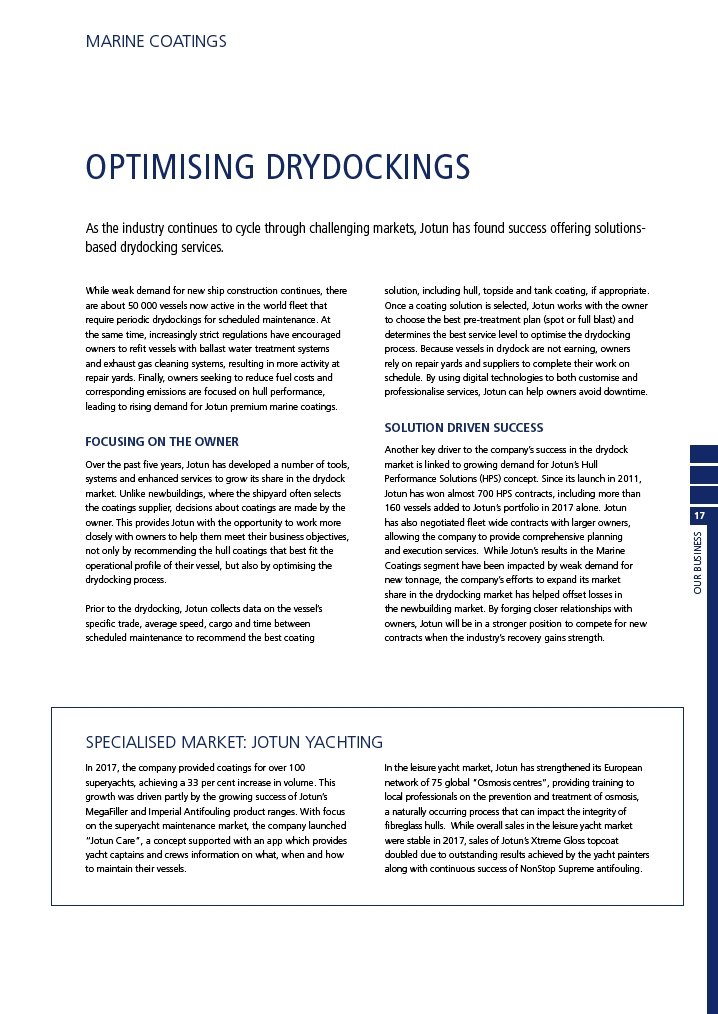
17
OUR BUSINESS
MARINE COATINGS
OPTIMISING DRYDOCKINGS
As the industry continues to cycle through challenging markets, Jotun has found success offering solutionsbased
While weak demand for new ship construction continues, there
are about 50 000 vessels now active in the world fleet that
require periodic drydockings for scheduled maintenance. At
the same time, increasingly strict regulations have encouraged
owners to refit vessels with ballast water treatment systems
and exhaust gas cleaning systems, resulting in more activity at
repair yards. Finally, owners seeking to reduce fuel costs and
corresponding emissions are focused on hull performance,
leading to rising demand for Jotun premium marine coatings.
FOCUSING ON THE OWNER
Over the past five years, Jotun has developed a number of tools,
systems and enhanced services to grow its share in the drydock
market. Unlike newbuildings, where the shipyard often selects
the coatings supplier, decisions about coatings are made by the
owner. This provides Jotun with the opportunity to work more
closely with owners to help them meet their business objectives,
not only by recommending the hull coatings that best fit the
operational profile of their vessel, but also by optimising the
drydocking process.
Prior to the drydocking, Jotun collects data on the vessel’s
specific trade, average speed, cargo and time between
scheduled maintenance to recommend the best coating
solution, including hull, topside and tank coating, if appropriate.
Once a coating solution is selected, Jotun works with the owner
to choose the best pre-treatment plan (spot or full blast) and
determines the best service level to optimise the drydocking
process. Because vessels in drydock are not earning, owners
rely on repair yards and suppliers to complete their work on
schedule. By using digital technologies to both customise and
professionalise services, Jotun can help owners avoid downtime.
SOLUTION DRIVEN SUCCESS
Another key driver to the company’s success in the drydock
market is linked to growing demand for Jotun’s Hull
Performance Solutions (HPS) concept. Since its launch in 2011,
Jotun has won almost 700 HPS contracts, including more than
160 vessels added to Jotun’s portfolio in 2017 alone. Jotun
has also negotiated fleet wide contracts with larger owners,
allowing the company to provide comprehensive planning
and execution services. While Jotun’s results in the Marine
Coatings segment have been impacted by weak demand for
new tonnage, the company’s efforts to expand its market
share in the drydocking market has helped offset losses in
the newbuilding market. By forging closer relationships with
owners, Jotun will be in a stronger position to compete for new
contracts when the industry’s recovery gains strength.
drydocking services.
In 2017, the company provided coatings for over 100
superyachts, achieving a 33 per cent increase in volume. This
growth was driven partly by the growing success of Jotun’s
MegaFiller and Imperial Antifouling product ranges. With focus
on the superyacht maintenance market, the company launched
“Jotun Care”, a concept supported with an app which provides
yacht captains and crews information on what, when and how
to maintain their vessels.
In the leisure yacht market, Jotun has strengthened its European
network of 75 global “Osmosis centres”, providing training to
local professionals on the prevention and treatment of osmosis,
a naturally occurring process that can impact the integrity of
fibreglass hulls. While overall sales in the leisure yacht market
were stable in 2017, sales of Jotun’s Xtreme Gloss topcoat
doubled due to outstanding results achieved by the yacht painters
along with continuous success of NonStop Supreme antifouling.
SPECIALISED MARKET: JOTUN YACHTING